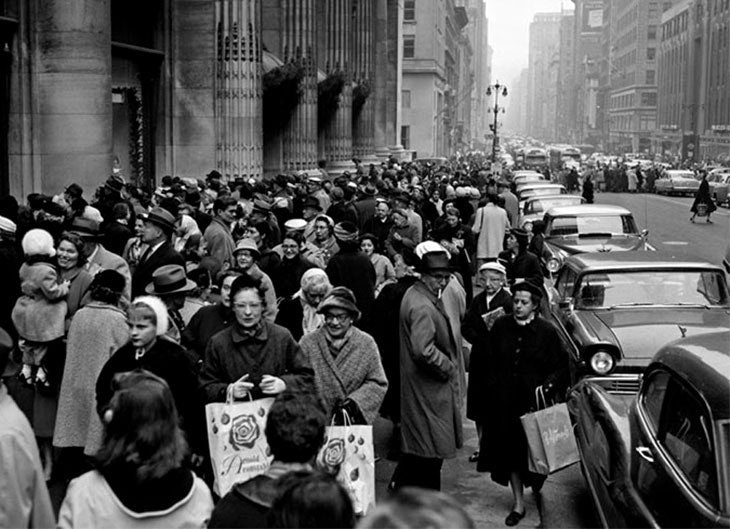
There is no doubt that this year, more than ever, we all need something to look forward to which makes the upcoming Black Friday, reportedly the most anticipated and likely the biggest shopping event of this year, a red letter date in the diary. ‘Black Friday’ is a term that is part of common parlance today, but how did it actually evolve?
The first use of the term ‘Black Friday’ did not apply to retail activities or consumerism, but rather to a devastating and infamous day on the New York Stock Exchange, on which an attempt to manipulate the gold prices by two Wall Street financiers, Jay Gould and James Fisk, led to the U.S. Treasury’s intervention calculated to break the financiers’ dangerous grip on the U.S. gold market. On 24 September 1869, the U.S, government authorised the sale of $4m worth of gold sending gold stocks plummeting. This led to a financial crisis, and many fortunes were destroyed in a single day: ‘Possibly no avalanche ever swept with more terrible violence.’ - The New York Herald later wrote of the event, and the term ‘Black Friday’ was quickly coined by the press.
However, it was not until the 1950s that the term ‘Black Friday’ slowly trickled into public consciousness once again. Since the late 19th century, when President Abraham Lincoln designated the Thanksgiving holiday as the last Thursday in November, the Friday after Thanksgiving has become the unofficial beginning of the Christmas shopping season – a starting gun, if you will, for the festive spending spree to begin.
The timing of Black Friday was shrewd; the glossy U.S. department stores respectfully refrained from embarking on Christmas campaigns until after Thanksgiving so as not to be seen to be dismissive of the poignant holiday landmark in the U.S. calendar. But, the moment the Thanksgiving meal had been consumed, the department stores were ready to unveil their all-important Christmas offers to the increasingly consumeristic and wealthy public, eager to start their Christmas shopping. 
The use of the phrase connoting the day of frenzied shopping however, seems to trace back to the disgruntled police officers, when in the 1950s, the Philadelphia police force began to refer to the day after Thanksgiving as ‘Black Friday’. Their reasoning was clear: it aptly described the utter chaos, traffic jams and shoplifting incidents caused by the unprecedented influx of, not only the suburban shoppers that flooded the city, but also the many tourists who began arriving for the annual Army-Navy football game, which incidentally, was played in the city at the same time. The combined crowd control problems of both shoppers and football fans meant long hours and chaotic scenes for the force.
By 1975, after the New York Times had recognised the phenomenon and used the term ‘Black Friday’, the marketing savvy U.S. retailers found a way to link it to the profits the post-Thanksgiving sales brought and to remove the negative and doom-laden connotation of the term, thereby transforming it into a positive and much awaited shopping event we associate the term ‘Black Friday’ with today.
It has long been an accounting practice in the U.S. to record financial details by hand and to note profits in black, while losses were entered in red. With difficult trading conditions, many retailers were ‘in the red’ throughout most of the year, but ‘went into the black’ following the shopping spree of Black Friday, when their goods just flew off the shelves, while crowds of shoppers spent huge sums of money on discounted merchandise. Very soon the term’s dark roots in Philadelphia were largely forgotten and Black Friday shopping has become vital to retailers, big and small, throughout the U.S.
By the 2000s, the trend gained considerable following and not only has a form of Black Friday tourism evolved, with international shoppers heading to the States to take advantage of the offers and possibly soak up the Christmassy atmosphere in destinations like New York and Chicago, but, along with the U.S., the Black Friday sales concept has emerged in other countries across the globe including the UK, France, Germany, Brazil, India, Australia, South America and the Far East. In Mexico, Black Friday is called ‘El Buen Fin’, which means ‘The Good End’ while in the United Arab Emirates, retailers discount their prices on ‘White Friday’. And so today, the Black Friday concept of shopping has become an international phenomenon.
However your own shopping excursion needn’t be so far flung. While we have all seen the Black Friday frenzied scenes on the high street over the years, at Truefitt & Hill we decided to take a much more gentlemanly approach and our curated online offering will apply a 20% discount to our selected range of toiletries, from colognes and shaving creams to hair styling products.
As the oldest barbershop in the world, we also like to offer something a little more special, which is why we are inviting you to join our Gentleman’s Club and to subscribe to our newsletter so as to receive early access to our Black Friday offers.
Whether you hanker after one of Truefitt’s colognes for yourself or a traditional shaving set for someone else’s Christmas stocking, indulging with a few clicks on the laptop could not be easier. So start the festive shopping season in fine style, all from the comfort of your own sofa.
Photographer unknown
